

Twitter. 4 K-12 professional development trends to watch in 2021. Editor’s note: This story is part of a series on the trends that will shape K-12 in 2021.

You can find all the articles on our trendline. Twitter. A Common Professional Development Mistake. If you think others need to see this, share it on one of the sites below by clicking on the button.

I think that professional development providers, certainly including myself, often miss the mark and commit a common mistake when they tell attendees what they need to do but don’t leave them equipped to implement it. To explain this, consider how we teach students what to do during a fire. The two most common options are providing a map (like you see in hotel rooms) or by simulating the experience through a fire drill (like you see in schools). Tika Epstein sur Twitter : "Yes! That is exactly what we are doing for our weekly #PLCs. We are sending our teachers the @achievethecore webinars or articles from a edumagazine. We also send them the questions we would like them to focus on. It has allowe.
Here's the recording of today's webinar with captions. Please share with anyone who is provides professional development for teachers.… Professional Learning Design 101. Not all of us are called to the unique position of leading rooms full of strangers through professional development workshops, but for those of us who are–fear not.
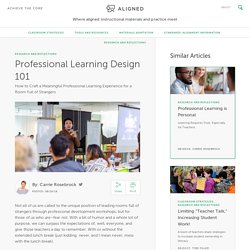
With a bit of humor and a whole lot of purpose, we can surpass the expectations of, well, everyone, and give those teachers a day to remember. With or without the extended lunch break (just kidding; never, and I mean never, mess with the lunch break). A Teacher-Centric Approach to PD. The term professional development is one that many educators have come to hate—it’s automatically equated with a lot of “sit and get” and a waste of precious time. As a library media specialist, I have probably shared these experiences more than most, as much of the professional development (PD) I’ve received over the years has had little relevance to my job.
Goal-Setting for Teachers: 8 Paths for Self-Improvement. Moodle. When we think of traditional professional development, we often picture an “expert” at the front of the room, disseminating knowledge based on research.

If we are fortunate, there are opportunities for audience participation in the form of digital polls, opportunities to work in groups or speak with a partner, or even step by step instructions to follow as the presenter guides us through a process of filling out a graphic organizer or creating a digital resource. The PD Teachers Want to Truly Improve Their Teaching. I have been a teacher for over 20 years.
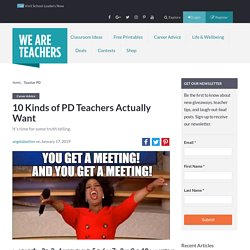
Do you know how many times I have been truly inspired by professional development? Well, you can count them on two hands. The other hundred or so times, I felt worse than I did when I entered the sessions. The words “bored,” “frustrated” and “irrelevant” come to mind. 18 billion dollars are spent on professional development in the US each year. Teacher-Led Learning: A Key Part of a Balanced PD Diet. What I've Learned From Being A Presenter. If you think others need to see this, share it on one of the sites below by clicking on the button.
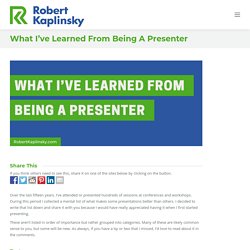
Over the last fifteen years, I’ve attended or presented hundreds of sessions at conferences and workshops. During this period I collected a mental list of what makes some presentations better than others. I decided to write that list down and share it with you because I would have really appreciated having it when I first started presenting. These aren’t listed in order of importance but rather grouped into categories. Many of these are likely common sense to you, but some will be new. The text on your slide needs to be at least 32 pt so that everyone can easily read it. 20 Questions That Schools Should Be Asking About Professional Development. Response: Do Professional Development 'With' Teachers, Not 'to' Them.
(This is the first post in a four-part series) The new question-of-the-week is: What are the biggest problems with common teacher professional development practices and how can they be fixed?

Say Goodbye to Boring PD: Rethinking Technology’s Role in Professional Development. Before I became an administrator, I spent 25 years teaching in the classroom.
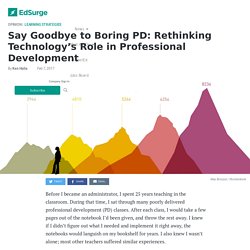
During that time, I sat through many poorly delivered professional development (PD) classes. After each class, I would take a few pages out of the notebook I’d been given, and throw the rest away. I knew if I didn’t figure out what I needed and implement it right away, the notebooks would languish on my bookshelf for years. I also knew I wasn’t alone; most other teachers suffered similar experiences. After a while, I started teaching my own PD courses. Edutopia. Giving Truly Useful PD Within the School Day 1.
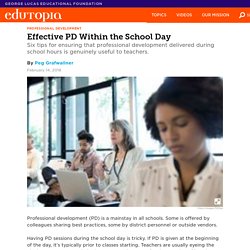
Keep it simple: Stick to a specific topic. The 3 Components Of True Change - Robert Kaplinsky. If you think others need to see this, share it on one of the sites below by clicking on the button.

If you’re a professional development provider, it can be disheartening when you think about your training’s effectiveness. The participant evaluations written at the end of your training might be glowing with your praises, but when you check in with attendees a day later, a week later, a month later, or a year later, are the changes in their practice visible? If not, how effective was your training? That can be an uncomfortable question to answer. Can Micro-credentials Create More Meaningful Professional Development For Teachers?
Learning science says people learn best when they apply new information to their own contexts. When learners can make mistakes, reflect on new strategies, get feedback, and try again they gain a deeper understanding of the topic. Education Week. —Courtesy of Allison Shelley/The Verbatim Agency for American Education: Images of Teachers and Students in Action. By Ernie Rambo One week before Labor Day 30 years ago, I met my first public school class: 30 6th graders standing on the playground of their brand-new school, ranging in height from short and cute to intimidatingly tall. We started that year together feeling privileged to have a classroom TV and weekly trips to the computer lab. Not one of us had ever used a cellphone, nor did we know of the laser projectors or SMART Boards that would eventually become commonplace in classrooms.
The most exciting piece of technology in our school was the library’s security system. 8 Reflective Questions To Help Any Student Think About Their Learning - 8 Reflective Questions To Help Any Student Think About Their Learning by TeachThought Staff For in-person professional development from TeachThought on reflection in learning or any other topic your school or district might need, contact us today. What’s the big deal about thinking about something that already happened?
In our ’10 Characteristics Of A Highly-Effective Learning Environment‘, we suggested that learning habits–reflection, for example–were constantly present and modeled. 9. Cognitive, meta-cognitive, and behavioral “good stuff” is constantly modeled. Monkey see, monkey do. CAR Facilitator Brochure. Professional Development: What should it look like? – Thinking Mathematically.
A few weeks ago Michael Fenton asked on his blog this question: Suppose a teacher gets to divide 100% between two categories: teaching ability and content knowledge. What’s the ideal breakdown? The question sparked many different answers that showed a very wide range of thinking, from 85%/15% favouring content, to 100% favouring pedagogy. In general though, it seems that more leaned toward the pedagogy side than the content side. Ww2.kqed. 21st-Century PD: Retention, Reflection, and Redistribution of Knowledge. The explosion of information available to educators for supporting classroom instruction is at an all-time high. Books, journals, blogs, forums, websites, social media, and peer-to-peer sharing create a wealth of resources for those entering the teaching profession. In the past 20 years, the landscape has shifted so severely around access to the best ideas and information that it has been impossible for educators to keep up. Because of this, many educators have declared information bankruptcy and retreated to a few safe places to access information.
This was inevitable -- no one can learn, absorb, and implement this flood of ideas as the profession's complexity continues to grow. Productive PD: Learning by Doing. "Are you kidding me? " I thought when the instructor gave the task. Launch Video Classroom Observations With New Toolkit. For busy teachers, there are limited opportunities within the school day to be observed, to observe other teachers, to pause and reflect on the details of specific classroom moments, and to receive support from colleagues. Since in-person observations may be difficult to arrange, teachers may find themselves going it alone when trying out new learning, refining practice, or facing challenges in their classroom -- at times without much feedback or support. Supporting Excellent Teaching of Common Core Content and Practices with Video Clubs.
Teachers face many challenges helping students meet the expectations set forth in the Common Core State Standards for Mathematics (CCSSM) (CCSSI 2010). CCSSM content standards not only introduce new concepts at each grade level but also require teachers to learn new terminology for old concepts and consider how students’ understanding of concepts builds across grades. The Common Core’s Standards for Mathematical Practice (SMP) pose an even greater challenge, as these “habits of mind,” or processes for doing mathematics, will be assessed in many states for the first time.
And, of course, CCSSM expectations demand such effective teaching practices as those outlined in Principles to Actions: Ensuring Mathematical Success for All (NCTM 2014). Supporting Excellent Teaching of Common Core Content and Practices with Video Clubs. 21st-Century PD: Retention, Reflection, and Redistribution of Knowledge. Survey Says, It's the Dawn of a New Era in Professional Learning; Plus 6 Favorite PD Resources for Teachers.
Ask school leaders what is needed to help teachers integrate technology into teaching and learning, and they’ll tell you that teachers need more professional learning and support. At a recent Consortium for School Networking’s (CoSN) conference, educational consultant and retired superintendent Gabe Soumakian summed it up concisely, “It’s not about the tech, it’s about the professional learning.” Professional Development is Broken, but Be Careful How We Fix It. Education Week. Edutopia. How Maryland is Putting the 'PLAY' Back into Professional Development. 3 Ways to Fix District PD—Tap Internal Talent, Analyze Your Data Footprint, and Listen. 8 Top Tips for Highly Effective PD. Highly effective classrooms can result from highly effective professional development. Recent research (Butler et al., 2004) has shown that effective professional development includes creating classroom content, modeling techniques for teachers to use in their classrooms, and feedback on lessons (Harris, Graham, and Adkins, 2015).
It's not enough to teach the right things to your teachers -- you have to teach your teachers in the right way. Book: Professional Development That Sticks: How do I create meaningful learning experiences for educators? (ASCD Arias) TeachThought PD – Personalized Professional Development For Schools. The Delicate Dance of Professional Development -
7 Characteristics of Great Professional Development -